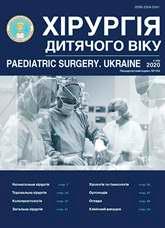Surgical treatment of the small intestine atresia under conditions of different postoperative follow-up
DOI:
https://doi.org/10.15574/PS.2020.69.7Keywords:
small intestine atresia, surgical treatment, childrenAbstract
Introduction. Small intestine atresia is one of the most common causes of low bowel obstruction in newborns. Mortality in this pathology ranges from 5 to 60%, depending on the country. Modern views about surgical correction are rather contradictory.
Purpose. To analyze the surgical treatment of small intestine atresia in the surgical department of the City Children’s Hospital No. 1 ССH) (Chernivtsi, Ukraine) and the surgical department Saint Damien Pediatric Hospital NPH (SDH) (Port-o-Prence, Haiti). To determine the best methods of surgery.
Materials and methods. The surgical treatment of 15 children under the conditions of SDH (Haiti) and 12 children under conditions of the city children’s clinical hospital (CCH, Chernivtsi) with atresia of the small intestine was analyzed. Determined the effectiveness of closed (oblique «end-to-end» anastomosis, taping with «end-to-end» anastomosis, Denis-Brown and Louw anastomoses), discharging (U- and T-shaped, taping with anostomosing and suspended proximal enterostoma), anastomoses and stomas (end, double, according to Mikulich). Mortality with limited parenteral nutrition was 40% (SDH), with the presence of parenteral nutrition – 33.33% (ССH, Chernivtsi).
Results. According to the analyzed data, we believe that the use of the method of surgical treatment should correspond to the type of atresia, the distance of the blind proximal end from the Treitz ligament, the difference in the diameters of the adducting and abducting sections, the possibility of parenteral nutrition, and the threat of short bowel syndrome (SCS).
Conclusions. Y-shaped discharging anastomosis «side-to-side» with the removal of the proximal area in the form of a stoma, can be the method of choice in case of significant difference between the intestinal diameters. It provides a wide area of the small bowel junction, chyme abduction until the fistula heals, and can be used for different types of small bowel atresia.
The research was carried out in accordance with the principles of the Helsinki Declaration. The study protocol was approved by the Local Ethics Committee of participating institution.
References
Abdelmohsen SM, Osman MA. (2017). Multiple Ileal Atresia with total Colonic Atresia, A Case Report. Madridge J Case Rep Stud. 1(1): 16-19. https://doi.org/10.18689/mjcrs-1000104
Aggerwal N, Sugandhi N, Kour H, Chakraborty G, Acharya SK, Jadhav A, Bagga D. (2019). Total intestinal atresia: Revisiting the pathogenesis of congenital atresias. J Indian Assoc Pediatr Surg. 24: 303-306. https://doi.org/10.4103/jiaps.JIAPS_204_18; PMid:31571767 PMCid:PMC6752068
Bairov VG, Amidhonova SA, Shchegoleva NA, Azizov BD, Hidirov AF. (2015). Kriterii vybora sposoba sozdaniya anastomoza u novorozhdennyh s tonkokishechnoj neprohodimost'yu. Detskaya hirurgiya. 19(1): 15-20.
Charlorin P, Louima O, Pierre GS, Peigne R, Bowder A, Grazia Maria A, Sylvio A. (2020). Use of feeding jejunostomy in a type IV jejuno-ileal atresia in a low-income country. Journal of Pediatric Surgery Case Reports. https://doi.org/10.1016/j.epsc.2020.101580
Chirdan LB, Uba AF, Pam SD. (2004). Intestinal atresia: management problems in a developing country Pediatr Surg Int. 20: 834-837. https://doi.org/10.1007/s00383-004-1152-4; PMid:15138787
Sliepov O, Migur M, Ponomarenko O, Gladishko O, Markevich H. (2018). Longitudinal enteroplasty as a method of primary treatment in newborns with proximal jejunal atresia. Paediatric surgery. Ukraine. 4(61): 87-92. https://doi.org/10.15574/PS.2018.61.87
Sliepov O, Migur M, Soroka V. (2017). Surgical treatment of congenital jejunoileal obstruction in newborns. Paediatric surgery. Ukraine. 2(55): 70-75. https://doi.org/10.15574/PS.2017.55.70
Sliepov OK, Migur MYu, Juravel AO. (2017). Risk factors and their influence on surgical results of congenital jejunoileal obstruction in infants. Perinatologiya i pediatriya. 2(70): 108-112. https://doi.org/10.15574/PP.2017.70.108
Suhotnik IG. (2017). Sindrom korotkoj kishki u detej. Rossijskij vestnik detskoj hirurgii anesteziologii i reanimatologii. 7(3): 99–116. Bibliogr.: 111–116. ISSN 2219-4061.
Downloads
Published
Issue
Section
License
The policy of the Journal “PAEDIATRIC SURGERY. UKRAINE” is compatible with the vast majority of funders' of open access and self-archiving policies. The journal provides immediate open access route being convinced that everyone – not only scientists - can benefit from research results, and publishes articles exclusively under open access distribution, with a Creative Commons Attribution-Noncommercial 4.0 international license(СС BY-NC).
Authors transfer the copyright to the Journal “PAEDIATRIC SURGERY.UKRAINE” when the manuscript is accepted for publication. Authors declare that this manuscript has not been published nor is under simultaneous consideration for publication elsewhere. After publication, the articles become freely available on-line to the public.
Readers have the right to use, distribute, and reproduce articles in any medium, provided the articles and the journal are properly cited.
The use of published materials for commercial purposes is strongly prohibited.

